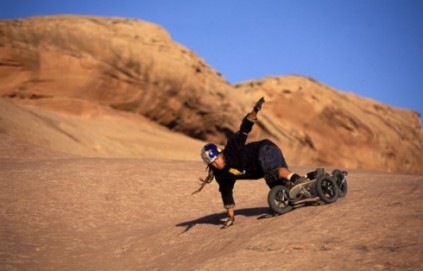Mountainboarding, mountain table, mountain board or mountain board, abbreviated as MB, is an extreme sport derived from different skating sports with boards, such as skateboarding and snowboarding.1 A mountainboard is a kind of all-terrain skateboard, whose Components include a board, somewhat larger than a normal skateboard, with fixings to secure the feet of the surfer, four large wheels with tires, two nylon foot straps and two steering mechanisms known as trucks.2 On some models, They use brake systems. Mountainboarders, also known as riders or riders (from the English verb to ride, “ride”) can run on all kinds of terrain, such as bmx tracks, downhill hills, skateparks, ski centers, streets, etc. It is this ability to ride on such a large variety of terrain that makes mountainboarding different from other board sports.
Parts
Table
Mountaiboard tables are where all the other components are attached and provides the basis on which the pilot can get on. These are generally 90-110 cm in length and can be manufactured from a wide variety of materials. For example, high quality boards can be made of carbon and glass reinforced plastic compounds, possibly with a wooden core, similar to a snowboard package. The most basic tables are made with pressed laminated wood, there are variable characteristics such as weight, flexibility, shape, etc.
Trucks
Trucks are the components formed by a suspension, damping and axles that connect the wheels to the board. There are different types of trucks.
Boot fixings
The fixings of boots involve adjustable straps that keep the pilot on the board while allowing space to move the feet.
Wheels
Several tires have been made available by the manufacturers of Mountainboard. giving athletes a choice of tire specifications. For example, the thickness of the tire is variable between the tires, usually 2 or 4 layers. 2-layer tires are lighter but more sensitive to punctures, unlike 4-layer tires are heavier and more resistant, the width and diameter is also variable.
Brakes
The brakes are generally reserved for large mountain walks, where riders need a greater capacity to control their speed over long distances. There are four types of brakes used in mountainboards.
Protection
Helmet: they are designed to protect the head of the bearers from the impact of falls. There are two types, full face, which provides greater protection to the user, and open face, which provides greater visibility for the user.
Wristbands: they are designed to protect and cushion the wrists in case of falls and blows.
Elbow pads: protects and cushions elbows from the impact of falls.
Knee pads: they are designed to protect users’ knees from the impact of falls.
Padded shorts: they are designed to protect users from the hips, coccyx and buttocks from the impact of falls.
Body armor: it is designed to protect users upper body, arms, shoulders and back from the impact of falls.
Circuit
The circuit, which lasts about 60 seconds from top to bottom, includes artificial highlights and ramps and is usually lowered in zigzag, to slow down.
Disciplines
Mountainboard has four main disciplines:
Downhill (DH) Descend timed from one to one, usually long stretches of approximately 1 km or more on mountain trails.
Boardercross (BoarderX, BX) Two to four competitors on a special running track.
Freestyle (FS) Slopestyle: Tricks or maneuvers on a track with jumps, rails and other innovative modules
Big Air: Do tricks or maneuvers like grabs, spins and inverts in a big jump.
Jibbing: Similar to Slopestyle except that the emphasis is placed on the most technical “tricks” made of rails, quarterpipes, drops and small kickers.
Freeriding (FR) Run free in places like forests, hills, etc.
Crossover Sports:
Skateboarding
Streetboarding
Surfing
Snowboarding
Wakeboarding
Mountain biking
Sandboarding
Dirtsurfing
Grassboarding






